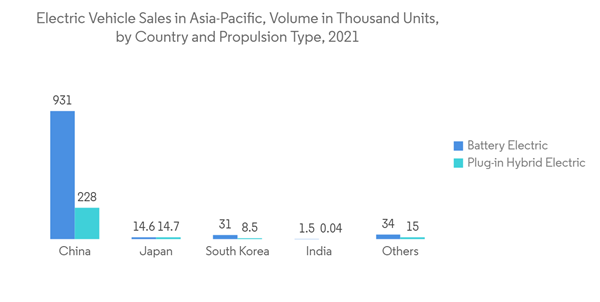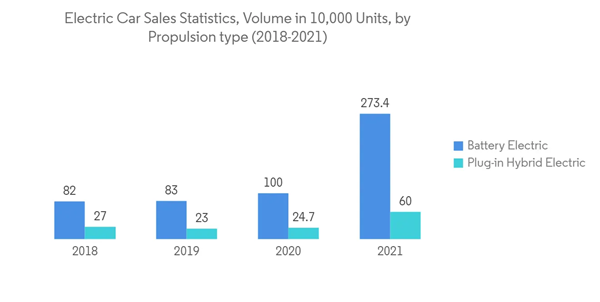Currently, the Asia-Pacific High-Performance Electric Vehicles Market is valued at USD 20 Billion and is expected to reach USD 80 Billion over five years, registering a CAGR of 25% during the forecast period.
The pandemic of COVID-19 had a minor impact on the APAC Automotive High-Performance Electric Vehicle market. The global lockdown significantly affected the automotive industry in terms of vehicle sales. As a result, the APAC Automotive High-Performance Electric Vehicles market was also affected. However, with rising environmental concerns, demand for electric vehicles is expected to rise, reviving the market's economic conditions following the pandemic.
Over the long term, growing awareness of vehicle emissions such as CO2, lower operating and maintenance costs, and increasing government initiatives to encourage the use of electric vehicles may contribute significantly to the growth of high-performance electric cars. In countries such as China, Japan, and Korea, consumer perception and willingness to purchase automobiles with new technologies drive demand for these vehicles. China and Japan are the region's most significant contributors to the EHPV market. The adoption of battery-electric vehicles in China has increased across the country.
Although these vehicles have only recently been introduced and their technology is still in its early stages, their growing popularity is expected to propel the market for HPEV in the Asia-Pacific region.
Fuel price fluctuations and reduced subsidies offered on plug-in hybrid vehicles in major markets such as China affect vehicle sales. In contrast, many automakers are introducing plug-in hybrid versions of existing vehicles, indicating that the market trend is shifting toward environmentally friendly plug-in hybrid vehicles.
Manufacturers such as Mercedes-Benz, Volvo, BMW, Volkswagen, Ford, Mitsubishi, and others have already launched plug-in-hybrid versions of existing IC engine vehicle models, accounting for a significant portion of global plug-in vehicle sales. China is the region's largest manufacturer of plug-in hybrid vehicles. The country is also the largest market for these vehicles, with leading manufacturers including BYD, SAIC, and BAIC.
FAME, which stands for Faster Adoption and Manufacturing of Hybrid and Electric Vehicles, is one such strategy. The government has decided to play a critical role in fostering demand for and acceptance of PHEVs and EVs, spurring collaborative R&D efforts, and allowing the necessary infrastructure to take shape. The government has also decided to implement a robust PHEV and EV demand-generation scheme in terms of size and duration to meet the goals of closing the PHEV and EV acquisition price gap when compared to a standard ICE vehicle. Furthermore, the aforementioned scheme is being implemented in order to create a manufacturing ecosystem that will allow these technologies to become viable. Government funding for R&D and electric vehicle infrastructure is thought to make it easier to develop affordable PHEV and EV solutions that meet consumer expectations.
The Indian government has developed a potential roadmap for transportation hybridization/electrification. This road map entails increasing consumer acceptability through incentives and subsidies. Furthermore, the government is likely to participate in the technology's application and development. Furthermore, the government may support automakers' local manufacturing capabilities. The Government of India intends to use this roadmap to make the electric vehicle and plug-in hybrid vehicle markets economically viable and self-sustaining.
Toyota planned to introduce more plug-in hybrid versions of existing vehicle models due to rising sales of plug-in hybrid vehicles in Asia Pacific, particularly in China. The company intends to introduce plug-in hybrid versions of the Corolla and Levin in the country.
Furthermore, General Motors, the US automaker, plans to launch more than ten plug-in hybrid electric vehicles, including PHEV versions of existing models such as the Cadillac CT6, which may be manufactured in Shanghai. The company's joint venture with SAIC is expected to be the country's manufacturing plant for plug-in hybrid vehicles.
This product will be delivered within 2 business days.
The pandemic of COVID-19 had a minor impact on the APAC Automotive High-Performance Electric Vehicle market. The global lockdown significantly affected the automotive industry in terms of vehicle sales. As a result, the APAC Automotive High-Performance Electric Vehicles market was also affected. However, with rising environmental concerns, demand for electric vehicles is expected to rise, reviving the market's economic conditions following the pandemic.
Over the long term, growing awareness of vehicle emissions such as CO2, lower operating and maintenance costs, and increasing government initiatives to encourage the use of electric vehicles may contribute significantly to the growth of high-performance electric cars. In countries such as China, Japan, and Korea, consumer perception and willingness to purchase automobiles with new technologies drive demand for these vehicles. China and Japan are the region's most significant contributors to the EHPV market. The adoption of battery-electric vehicles in China has increased across the country.
Although these vehicles have only recently been introduced and their technology is still in its early stages, their growing popularity is expected to propel the market for HPEV in the Asia-Pacific region.
APAC Automotive High Performance Electric Vehicles Market Trends
Increasing Demand for Plug-in Hybrid Electric Vehicles
China, the region's largest automobile market, is also the region's largest market for high-performance electric vehicles, followed by Japan. The Asia-Pacific region's emission regulations and subsidies for hybrid and electric vehicles aided it in capturing a sizable share of the overall electric and hybrid vehicle market. Although grants and emission standards have helped increase green vehicle sales, the global share of plug-in electric vehicles is less than 1%.Fuel price fluctuations and reduced subsidies offered on plug-in hybrid vehicles in major markets such as China affect vehicle sales. In contrast, many automakers are introducing plug-in hybrid versions of existing vehicles, indicating that the market trend is shifting toward environmentally friendly plug-in hybrid vehicles.
Manufacturers such as Mercedes-Benz, Volvo, BMW, Volkswagen, Ford, Mitsubishi, and others have already launched plug-in-hybrid versions of existing IC engine vehicle models, accounting for a significant portion of global plug-in vehicle sales. China is the region's largest manufacturer of plug-in hybrid vehicles. The country is also the largest market for these vehicles, with leading manufacturers including BYD, SAIC, and BAIC.
China is The Largest Market
With growing concerns about environmental pollution, the government has pushed back the implementation of the next stage of emission standards, Bharat Stage 6, from 2024 to April 1, 2020. The government is implementing a number of policies to reduce pollution in the country.FAME, which stands for Faster Adoption and Manufacturing of Hybrid and Electric Vehicles, is one such strategy. The government has decided to play a critical role in fostering demand for and acceptance of PHEVs and EVs, spurring collaborative R&D efforts, and allowing the necessary infrastructure to take shape. The government has also decided to implement a robust PHEV and EV demand-generation scheme in terms of size and duration to meet the goals of closing the PHEV and EV acquisition price gap when compared to a standard ICE vehicle. Furthermore, the aforementioned scheme is being implemented in order to create a manufacturing ecosystem that will allow these technologies to become viable. Government funding for R&D and electric vehicle infrastructure is thought to make it easier to develop affordable PHEV and EV solutions that meet consumer expectations.
The Indian government has developed a potential roadmap for transportation hybridization/electrification. This road map entails increasing consumer acceptability through incentives and subsidies. Furthermore, the government is likely to participate in the technology's application and development. Furthermore, the government may support automakers' local manufacturing capabilities. The Government of India intends to use this roadmap to make the electric vehicle and plug-in hybrid vehicle markets economically viable and self-sustaining.
APAC Automotive High Performance Electric Vehicles Market Competitor Analysis
The most prominent players in the high-performance electric vehicle market are Toyota Motor Corporation, Daimler (Mercedes-Benz), BMW, Hyundai, Nissan, and Kia. OEMs are concentrating on developing more affordable electric vehicles with more fantastic ranges. For instance,- November 2022: Hindustan Motors announced the signing of a Memorandum of Understanding (MOU) to expand its electric vehicle domain across the border to improve the production of an eco-friendly electric vehicle.
Toyota planned to introduce more plug-in hybrid versions of existing vehicle models due to rising sales of plug-in hybrid vehicles in Asia Pacific, particularly in China. The company intends to introduce plug-in hybrid versions of the Corolla and Levin in the country.
Furthermore, General Motors, the US automaker, plans to launch more than ten plug-in hybrid electric vehicles, including PHEV versions of existing models such as the Cadillac CT6, which may be manufactured in Shanghai. The company's joint venture with SAIC is expected to be the country's manufacturing plant for plug-in hybrid vehicles.
Additional benefits of purchasing the report:
- The market estimate (ME) sheet in Excel format
- 3 months of analyst support
This product will be delivered within 2 business days.
Table of Contents
1 INTRODUCTION
4 MARKET DYNAMICS
5 MARKET SEGMENTATION (Market Size in USD Billion)
6 COMPETITIVE LANDSCAPE
Companies Mentioned (Partial List)
A selection of companies mentioned in this report includes, but is not limited to:
- Toyota Motor Corporation
- BMW AG
- Nissan Motor Co. Ltd
- BYD Co. Ltd
- Hyundai Motor Company
- General Motors
- Kia Motors Corporation
- Honda Motor Co. Ltd
- Volkswagen AG
- Groupe Renault
- Daimler AG (Mercedes-Benz)
Methodology

LOADING...










